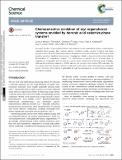Files in this item
Chemoselective oxidation of aryl organoboron systems enabled by boronic acid-selective phase transfer
Item metadata
| dc.contributor.author | Molloy, John J. | |
| dc.contributor.author | Clohessy, Thomas Aidan | |
| dc.contributor.author | Irving, Craig | |
| dc.contributor.author | Anderson, Niall A. | |
| dc.contributor.author | Lloyd-Jones, Guy C. | |
| dc.contributor.author | Watson, Allan J. B. | |
| dc.date.accessioned | 2018-02-07T14:30:07Z | |
| dc.date.available | 2018-02-07T14:30:07Z | |
| dc.date.issued | 2017-02-01 | |
| dc.identifier | 252198365 | |
| dc.identifier | 7904309a-a756-4de8-a08f-b3dc446009b2 | |
| dc.identifier | 85010976169 | |
| dc.identifier.citation | Molloy , J J , Clohessy , T A , Irving , C , Anderson , N A , Lloyd-Jones , G C & Watson , A J B 2017 , ' Chemoselective oxidation of aryl organoboron systems enabled by boronic acid-selective phase transfer ' , Chemical Science , vol. 8 , no. 2 , pp. 1551-1559 . https://doi.org/10.1039/C6SC04014D | en |
| dc.identifier.issn | 2041-6520 | |
| dc.identifier.other | RIS: urn:784C57318B2CB0C2E93AD65D102DE30A | |
| dc.identifier.other | ORCID: /0000-0002-1582-4286/work/56639203 | |
| dc.identifier.uri | https://hdl.handle.net/10023/12687 | |
| dc.description | The research leading to these results has received funding from the European Research Council under the European Union's Seventh Framework Programme (FP7/2007–2013)/ERC grant agreement no. [340163]. This work was supported by the EPSRC. We thank the EPSRC and GlaxoSmithKline (GSK) for PhD studentships (JJM and TAC), | en |
| dc.description.abstract | We report the direct chemoselective Brown-type oxidation of aryl organoboron systems containing two oxidizable boron groups. Basic biphasic reaction conditions enable selective formation and phase transfer of a boronic acid trihydroxyboronate in the presence of boronic acid pinacol (BPin) esters, while avoiding speciation equilibria. Spectroscopic investigations validate a base-promoted phase-selective discrimination of organoboron species. This phenomenon is general across a broad range of organoboron compounds and can also be used to invert conventional protecting group strategies, enabling chemoselective oxidation of BMIDA species over normally more reactive BPin substrates. We also demonstrate the selective oxidation of diboronic acid systems with chemoselectivity predictable a priori. The utility of this method is exemplified through the development of a chemoselective oxidative nucleophile coupling. | |
| dc.format.extent | 1505793 | |
| dc.language.iso | eng | |
| dc.relation.ispartof | Chemical Science | en |
| dc.subject | Aryl organoboron | en |
| dc.subject | Organoboron compounds | en |
| dc.subject | Chemoselective oxidative nucleophile coupling | en |
| dc.subject | QD Chemistry | en |
| dc.subject | NDAS | en |
| dc.subject.lcc | QD | en |
| dc.title | Chemoselective oxidation of aryl organoboron systems enabled by boronic acid-selective phase transfer | en |
| dc.type | Journal article | en |
| dc.contributor.institution | University of St Andrews. School of Chemistry | en |
| dc.identifier.doi | https://doi.org/10.1039/C6SC04014D | |
| dc.description.status | Peer reviewed | en |
This item appears in the following Collection(s)
Items in the St Andrews Research Repository are protected by copyright, with all rights reserved, unless otherwise indicated.

